Chickweed is often mistaken for a weed - in fact, chickweed is not only edible, but also extremely useful.
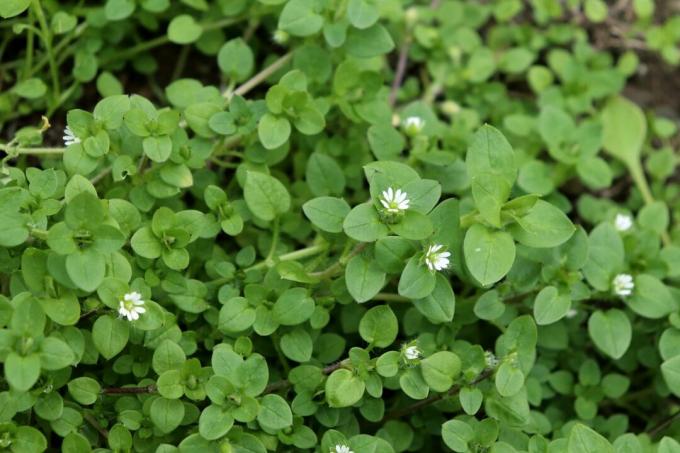
Almost every gardener knows the common chickweed (Stellaria media): The inconspicuous plant, which is also known as chickweed or chicken intestine, likes to spread on fallow vegetable beds or in the lawn - to the displeasure of many garden lovers. They see chickweed in the garden primarily as a weed that has to be painstakingly removed. On the other hand, only a few know the numerous positive properties of the common chickweed: the plant is namely not only edible, but also has a healing effect and can be extremely useful in the garden be. Here we will tell you how to recognize chickweed and how to use it in the garden.
contents
- recognize Chickweed
- Uses of chickweed: Can you eat chickweed?
- Plant chickweed in the garden
- Combat chickweed as a weed
recognize Chickweed
Newcomers often overlook chickweed in the garden - no wonder, after all, the delicate herb is rather inconspicuous. However, if you look closely, you can soon discover the herb in yourself. Chickweed is particularly adaptable and can therefore be found all over Germany on fields, in gardens, parks or along the way. Anyone looking for chickweed should pay attention to certain identifying features: Chickweed grows to a height of about 10 to 40 cm and usually forms flat carpets. Chickweed blossoms all year round in mild weather, with large numbers of small, white flowers that only open when the weather is good. Another feature that makes chickweed easy to recognize is its leaves: these are small, oval and pointed and sit in pairs opposite each other on the thin, soft stalk Plant. The plant also has what is known as a hairline on its stems, which means that a line of fine, soft hairs runs the full width of one side of the stem.
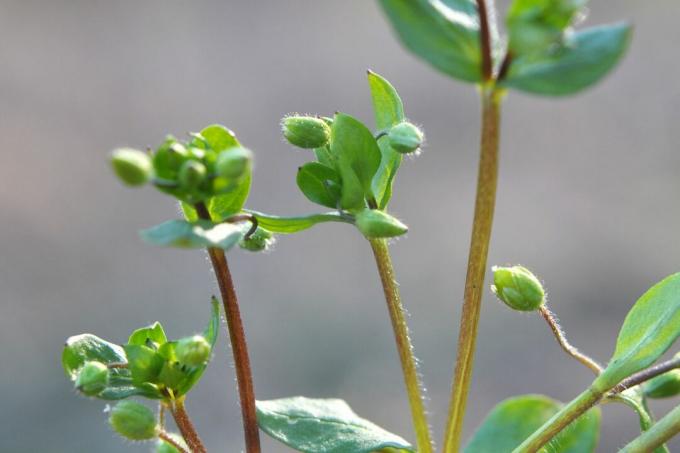
Where does chickweed grow?
- Occurrence throughout Germany
- Widespread in fields, parks, gardens and along roadsides
- Prefers nitrogen-rich, moist soil
- Does well in both sunny and shady places
What does Chickweed look like?
- 10 to 40 cm high
- Growing in flat carpets
- Numerous small, white flowers that can be seen throughout the year in mild weather
- Leaves oval, pointed and small, in pairs opposite each other on the stem
- Thin, soft stems with a hairline
Likelihood of confusion: Unfortunately, picking chickweed can also lead to confusion with other wild herbs. The confusion of chickweed with other chickweed species such as the chickweed (Stellaria aquatica) or the hagwort (Stellaria nemorum). Fortunately, this mix-up isn't a bad thing, since both types of chickweed are perfectly edible, even if they don't taste like chickweed. Commonly referred to as false chickweed is also the field gauchheil (Anagallis arvensis): This primrose plant is slightly poisonous and can cause headaches, nausea and circulatory problems if ingested. Acker-Gauchheil is easy to distinguish from chickweed, especially during the flowering period, as it over orange instead of white flowers has. In addition, the chickweed has the so-called hairline on, while this does not occur with Acker-Gauchheil.
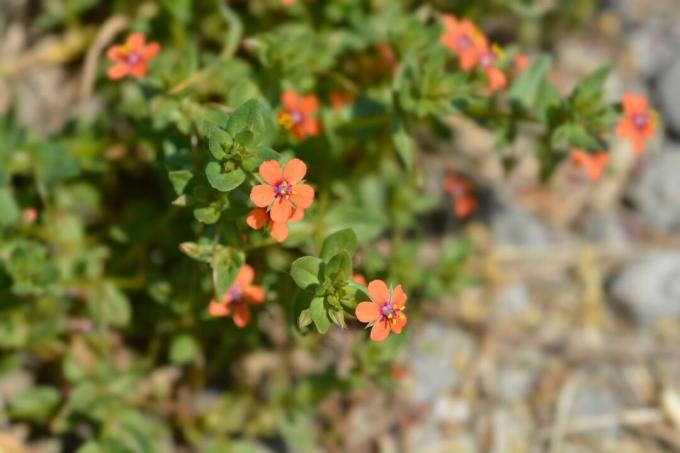
Uses of chickweed: Can you eat chickweed?
Chickweed was long considered a weed - but recently chickweed has been marketed as a real insider tip on the plate and is even offered in starred restaurants. The mild, spicy taste of the herb is vaguely reminiscent of young corn on the cob and inspires many. Chickweed recipes in particular, such as a chickweed salad, but also smoothies, herb butter or pesto are now real insider tips and a real treat for the palate. But the chickweed is not only suitable for eating raw – the herb can also be steamed and eaten like spinach. The plant not only convinces with its taste, because the Chickweed is also extremely healthy: The Plant contains many important vitamins and minerals such as vitamin A, potassium, phosphorus, and copper silica. In addition, 50 g of chickweed already cover the daily requirement of vitamin C for a person - this makes the plant one of the vegetables and herbs rich in vitamin C. In addition, chickweed contains the ingredient aucubin, which is said to have a positive effect on the immune system and to reduce aging processes. Chickweed is known for its health-promoting effects, especially in naturopathy found against numerous diseases - for example rheumatism, respiratory tract infections or bladder diseases - Commitment. Chickweed tea is a popular home remedy. For this, a tablespoon of dried chickweed is brewed with 250 ml of boiling water and left to steep for five to eight minutes.

Chickweed is not only used in the house - the plant can also be a useful addition to the garden. As the name suggests, birds in particular are particularly fond of the plant. Chickweed seeds provide a valuable food source for all sorts of garden birds, making the herb an uncanny asset for birds. In fact, chickweed was a popular chicken feed for a long time and is still popular today their own chickens in the garden, but also domestic birds such as budgies, are very concerned about the nutritious Snack. Chickweed also has a positive effect on soil life in the garden: as a ground cover it protects the soil from drying out or leaching and thus contributes to the maintenance of a healthy one soil. Since the plant is particularly persistent and hardy, it is also suitable for winter planting of beds.
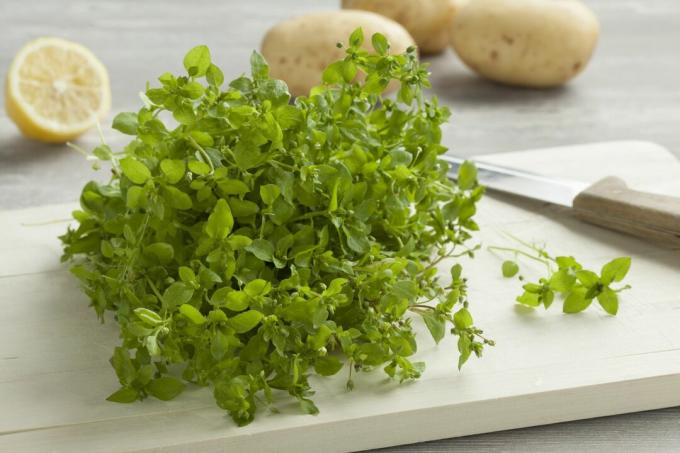
Plant chickweed in the garden
If you want to grow chickweed in the garden yourself, you don't need to be afraid of a lot of work and care have: The tireless and robust herb grows almost everywhere and needs almost none Attention. While the plant grows in both sunny and partially shaded locations, when it comes to soil, it prefers mostly nitrogen-rich substrates. In the case of particularly low-nitrogen soils, it is therefore advisable to first treat the soil with compost, horn shavings or an organic fertilizer with a long-term effect, such as ours Plantura organic universal fertilizer, to improve. If you don't already have some chickweed in your garden, you can simply harvest the seeds for cultivation from wild plants. Chickweed seeds can then be sown directly into the bed. Then the seeds are covered with about 5 mm of soil and watered thoroughly. Incidentally, there is a wide range of times for sowing chickweed: during the vegetation period between March and the end of September, the plants can be sown outdoors without any problems.
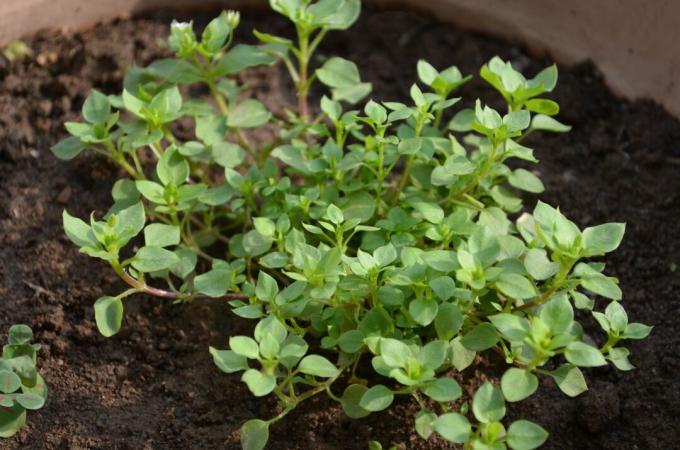
But not only the sowing of the chickweed is very simple, the plant also requires little care - only in hot summers is it important to ensure that the plant is sufficiently watered. However, the chickweed is very keen to reproduce, so it can spread quickly in the bed. In order to prevent propagation by self-seeding, the plants should always be cut off before seed formation.
Incidentally, chickweed can be harvested all year round. Either the young shoot tips or the entire plant are separated about 2 to 3 cm above the ground. The plant parts left in the ground will normally sprout again without any problems and can be harvested again after a few weeks. Chickweed is best used fresh, but it can also be dried or frozen.
Growing chickweed in the garden:
- Location: Sunny to shady, pot or outdoors
- Soil: Nitrogen-rich, preferably moist substrates
- Sowing: March to September
- Sow the seeds broadly, cover with 5 mm of soil and then water
- Water when dry
- Harvest possible all year round
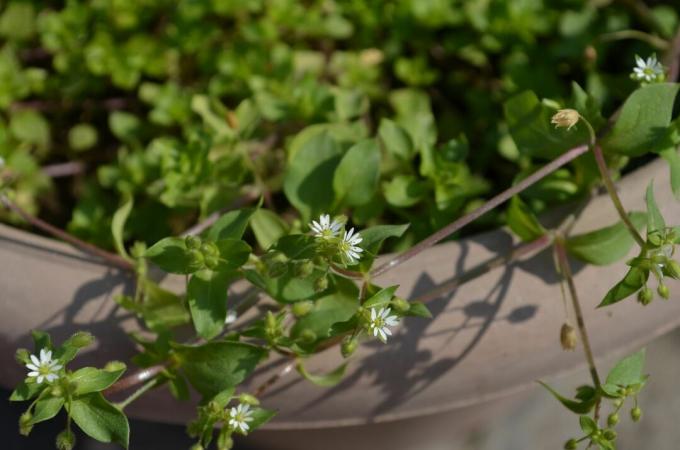
Tip: If you don't have a bed available, you can easily cultivate Chickweed in a pot both outside and on the windowsill. A nutrient-rich potting soil such as our peat-free is suitable for this Plantura organic universal soil particularly good.
Combat chickweed as a weed
Although chickweed offers many advantages in the garden, it can sometimes spread into areas where it is undesirable. If you want to keep your beds free of wild plants, you have several options for fighting chickweed:
Weeds like chickweed can be removed particularly gently with the proven weeding remove. When weeding, it is important to ensure that you remove the plant along with its roots.
That too Chop Chickweed does well due to the shallow roots - the plants can simply be left on the ground or on paths where they will dry out.
Tip: Alternatively, you can also use the chickweed removed when hoeing or weeding collect for your own consumption, add to the compost or leave for birds. In any case, however, it is extremely important to remove the plants before flowering to avoid seed spread.
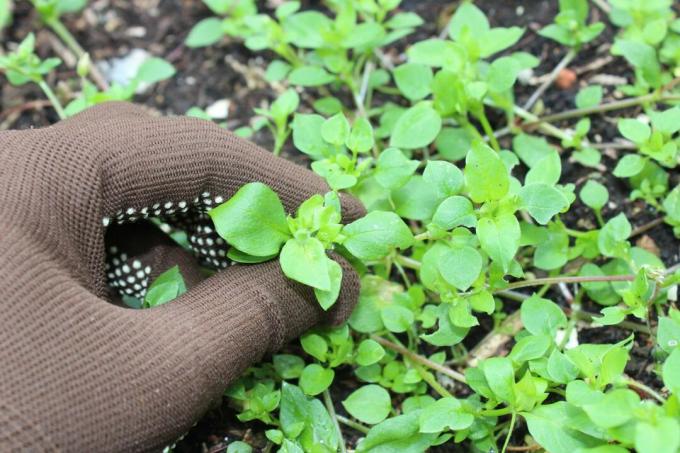
If the continuous weeding is too strenuous for you, you can also use other means. A proven way to avoid chicken gut infestation as a weed is to deprive it of the habitat it needs. This can be done in two ways: On the one hand, you can use other plants to close gaps in the garden where chickweed likes to spread. For planting under bushes and shrubs, for example, are suitable groundcover for the shadow very good. If planting with ground cover is difficult, for example between the plants in vegetable beds, one can also mulch layer reduce weed pressure and minimize chickweed growth and spread.
If chickweed appears in the lawn, it can too Scarifying and regular mowing remedy. While the plant is well caught and pulled out of the ground when scarifying, regular mowing prevents the chickweed from flowering and thus suppresses the further spread of the plant. Gaps caused by chickweed in the lawn should be closed as soon as possible, for example with ours Plantura lawn repair, so that no new chickweed can settle there.
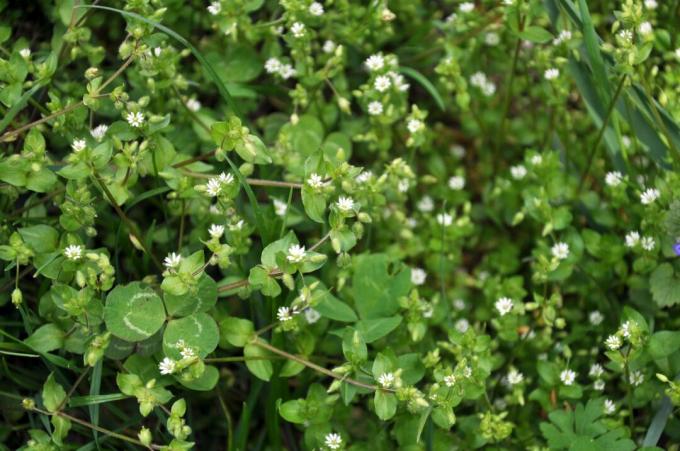
What to do about chickweed:
- Regular weeding or hoeing of the beds
- Close gaps in the bed with ground cover
- Cover gaps in the bed with mulch
- If there is chickweed in the lawn: Scarify and mow the lawn. Reseed gaps as soon as possible
Would you like to learn more about unusual types of vegetables for the garden? Here you will find all information about the hitherto rather unknown, but absolutely tasty strawberry spinach.



